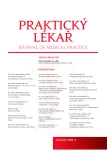Therapy of MODY in general practitioner’s surgery
Authors:
doc. MUDr. Ludmila Brunerová, Ph.D. 1; J. Urbanová 1; J. Brož 2
Authors‘ workplace:
Diabetologické centrum II. interní klinika 3. LF UK a FNKV, Praha Přednosta: prof. MUDr. Michal Kršek, CSc.
1; Interní klinika 2. LF UK a FN Motol, Praha Přednosta: prof. MUDr. Milan Kvapil, CSc., MBA
2
Published in:
Prakt. Lék. 2018; 98(5): 200-202
Category:
Of different specialties
Overview
Maturity-onset Diabetes of the Young (MODY) is autosomal dominant-inherited, yet clinically heterogeneous type of diabetes. In case of prognostically benign GCK-MODY no specific antidiabetic treatment is required (with pregnancy as an exception). However, in MODY of transcription factors, especially HNF1A-MODY, but also in less common HNF4A-MODY, the therapy, traditionally based on sulphonylurea derivatives (alternatively on glinides), is necessary. In case of failure of this therapy (usually after the long duration of HNF1A-MODY and HNF4A-MODY) initiation of insulin therapy is required. Insulin is also the first drug of choice in HNF1B-MODY. Use of other hypoglycaemic agents is yet experimental and the promising effects of particularly incretin therapy and gliflozins (probably rather in combination) will be needed to verify in larger studies. This review summarizes current available information about therapeutical options in MODY patients.
KEYWORDS:
MODY – oral hypoglycaemic drugs – insulin – treatment
Sources
1. Anık A, Çatlı G, Abacı A, Böber E. Maturity-onset diabetes of the young (MODY): an update. J Pediatr Endocrinol Metab 2015; 28(3–4): 251–263.
2. Tattersall RB. Mild familial diabetes with dominant inheritance. QJ Med 1974; 43 : 339–357.
3. Lebovitz HE. Oral hypoglycemic agents. Prim Care 1988; 15(2): 353–369.
4. Brunerova L, Rahelić D, Ceriello A, Broz J. Use of oral antidiabetic drugs in the treatment of maturity-onset diabetes of the young: A mini review. Diabetes Metab Res Rev 2018; 34(1). doi: 10.1002/dmrr.2940
5. Osbak KK, Colclough K, Saint-Martin C, et al. Update on mutations in glucokinase (GCK), which cause maturity-onset diabetes of the young, permanent neonatal diabetes, and hyperinsulinemic hypoglycemia. Hum Mutat 2009; 30 : 1512–1526.
6. Stride A, Shields B, Gill-Carey O, et al. Cross-sectional and longitudinal studies suggest pharmacological treatment used in patients with glucokinase mutations does not alter glycaemia. Diabetologia 2014; 57 : 54–56.
7. Brunerová L, Brož J, Průhová Š, Lebl J, et al. Maturity Diabetes of the Young 3. DMEV, 2006; 9(2): 57–61.
8. Dunne M, Cosgrove K, Shepherd M, et al. Potassium channels, sulphonylurea receptors and control of insulin release. Trends Endocrinol Metab 1999, 10(4): 146–152.
9. Shepherd M, Hattersley A. I don’t feel like a diabetic any more: the impact of stopping insulin in patients with maturity-onset diabetes of the young following genetic testing. Clin Med 2004; 4(2): 144–147.
10. Shepherd M, Pearson E, Houghton J, et al. No deterioration in glycaemic control in HNF-1α Maturity-Onset Diabetes of the Young following transfer from long-term insulin to sulphonylureas. Diab Care 2003; 26(11): 3191–3192.
11. Fajans SS, Brown MB. Administration of sulfonylureas can increase glucose-induced insulin secretion for decades in patients with maturity-onset diabetes of the young. Diabetes Care 1993; 16 : 1254–1261.
12. Brunerová L, Treslová L, Průhová S, a kol. Glibenklamid místo inzulinu: nová šance pro pacienty s MODY3 – kazuistika. Vnitř. Lék. 2006; 52(3): 275–279.
13. Pearson ER, Pruhova S, Tack CJ, et al. Molecular genetics and phenotypic characteristics of MODY caused by hepatocyte nuclear factor 4alpha mutations in a large European collection. Diabetologia 2005; 48 : 878–885.
14. Yoshiuchi I, Yamagata K, Yang Q, et al. Three new mutations in the hepatocyte nuclear factor-1alpha gene in Japanese subjects with diabetes mellitus: clinical features and functional characterization. Diabetologia 1999; 42(5): 621–626.
15. Pearson ER, Badman MK, Lockwood CR, et al. Contrasting diabetes phenotypes associated with hepatocyte nuclear factor-1alpha and -1beta mutations. Diabetes Care 2004; 27 : 1102–1107.
16. Pearson E, Starkey B, Powell R, et al. Genetic cause of hyperglycaemia and response to treatment in diabetes. Lancet 2003; 362(18): 1275–1281.
17. Tuomi T, Honkanen EH, Isomaa B, et al. Improved prandial glucose control with lower risk of hypoglycemia with nateglinide than with glibenclamide in patients with maturity-onset diabetes of the young type 3. Diabetes Care 2006; 29(2): 189–194.
18. Østoft SH, Bagger JI, Hansen T, et al. Glucose-lowering effects and low risk of hypoglycemia in patients with maturity-onset diabetes of the young when treated with a GLP-1 receptor agonist: a double-blind, randomized, crossover trial. Diabetes Care 2014; 37(7): 1797–1805.
19. Katra B, Klupa T, Skupien J, et al. Dipeptidyl peptidase-IV inhibitors are efficient adjunct therapy in HNF1-A maturity-onset diabetes of the young patients – report of two cases. Diabetes Technol Ther 2010; 12(4): 313–316.
20. Mangrum C, Rush E, Shivaswamy V. Genetically targeted dipeptidyl peptidase-4 inhibitor use in a patient with a novel mutation of MODY type 4. Clin Med Insights Endocrinol Diabetes 2015; 8 : 83–86.
21. Hohendorff J, Szopa M, Skupien J, et al. A single dose of dapagliflozin, an SGLT-2 inhibitor, induces higher glycosuria in GCK - and HNF1-A-MODY than in type 2 diabetes mellitus. Endocrine 2017; 57(2): 272–279.
22. Ovsyannikova AK, Rymar OD, Shakhtshneider EV, et al. ABCC8 Related Maturity-Onset Diabetes of the Young (MODY12): Clinical Features and Treatment Perspective. Diabetes Ther 2016; 7(3): 591–600.
23. Thanabalasingham G, Owen KR. Diagnosis and management of maturity onset diabetes of the young (MODY). BMJ 2011; 343: d6044.
24. Shepherd M, Brook AJ, Chakera AJ, et al. Management of sulfonylurea-treated monogenic diabetes in pregnancy: implications of placental glibenclamide transfer. Diabet Med 2017; 34(10): 1332–1339.
Labels
General practitioner for children and adolescents General practitioner for adultsArticle was published in
General Practitioner

2018 Issue 5
Most read in this issue
- Flu from a general practitioner’s point of view – case report
- Physical activity in seniors 65+ and its context with health literacy
- Dry form of age related macular degeneration and nutritional supplements, use of microperimetry
- Antibiotics resistance and importance of the horizontal transmission of genetic information
